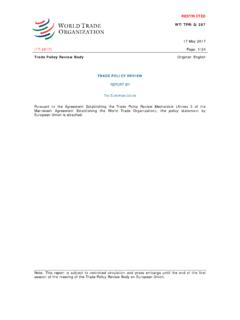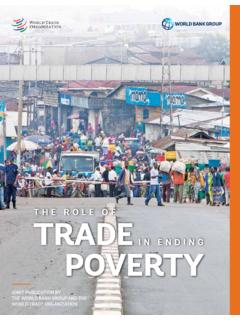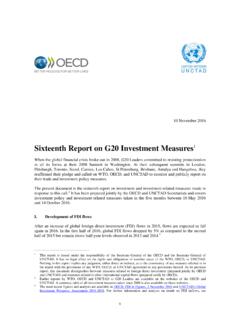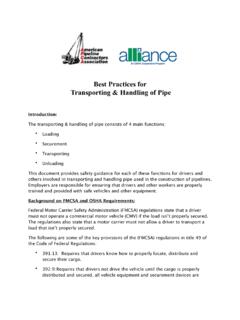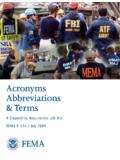Transcription of An Advanced Guide to Trade Policy Analysis: The Structural ...
1 An Advanced Guide to Trade Policy Analysis: The Structural Gravity ModelAn Advanced Guide to Trade Policy Analysis: The Structural Gravity ModelYoto V. Yotov, Roberta Piermartini,Jos -Antonio Monteiro,and Mario LarchWhat is An Advanced Guide to Trade Policy Analysis? An Advanced Guide to Trade Policy Analysis aims to help researchers and policymakers update their knowledge of quantitative economic methods and data sources for Trade Policy this Guide The Guide explains analytical techniques, reviews the data necessary for analysis and includes illustrative applications and exercises. Find out more Website: Advanced Guide to Trade Policy Analysis: The Structural Gravity gravity model: a workhorse of applied internationaltrade this guide6 CHAPTER 1: PARTIAL EQUILIBRIUM Trade Policy ANALYSIS WITH Structural and learning gravity: from theory to estimation: challenges, solutions andbest estimates: interpretation and data: sources and gravity distance puzzle Trade agreements the effects of the WTO the effects of unilateral Trade policy562 Appendices 57 Appendix A: Structural gravity from supply side 57 Appendix B: Structural gravity with tariffs 60 Appendix C: Databases and data sources links summary 63 Chapter 2: General equilibrium Trade Policy analysis with Structural gravity 67A.
2 Overview and learning objectives 69B. Analytical tools 701. Structural gravity: general equilibrium context 702. Standard approach to general equilibrium analysis with Structural gravity 883. A general equilibrium gravity analysis with the Poisson Pseudo Maximum Likelihood (GEPPML) 95C. Applications 1021. Trade without borders 1032. Impact of regional Trade agreements 111D. Exercises 1171. Calculating the general equilibrium impacts of removing a specific border 1172. Calculating the general equilibrium impacts of a regional Trade agreement 118 Appendices 119 Appendix A: Counterfactual analysis using supply-side gravity framework 119 Appendix B: Structural gravity with sectors 121 Appendix C: Structural gravity system in changes 126 References 1313 AUTHORSYoto V.
3 YotovDrexel University, CESifo and ERI-BASR oberta PiermartiniEconomic Research and Statistics Division, World Trade OrganizationJos -Antonio MonteiroEconomic Research and Statistics Division, World Trade OrganizationMario Larch University of Bayreuth, CESifo, ifo Institute, and GEP at University of NottinghamAcknowledgmentsThe authors would like to thank Michela Esposito for her comments and valuable research assistance. They also would like to thank Delina Agnosteva, James Anderson, Richard Barnett, Davin Chor, Gabriel Felbermayr, Benedikt Heid, Russell Hillberry, Lou Jing, Ma Lin, Antonella Liberatore, Andreas Maurer, Jurgen Richtering, Stela Rubinova, Serge Shikher, Costas Syropoulos, Robert Teh, Thomas Verbeet, Mykyta Vesselovsky, Joschka Wanner, Thomas Zylkin, as well as the seminar and workshop participants at the ifo Institute, the World Trade Organization, the World Bank, the International Trade Commission, Global Affairs Canada, the University of Ottawa, the Kiel Institute for the World Economy, the Tsenov Academy of Economics, and the National University of Singapore for helpful suggestions and discussions.
4 Thanks also go to Vlasta Macku (UNCTAD Virtual Institute) for her continuous support to this project and her role in initiating this inter-organizational cooperation. The production of this book was managed by WTO Publications. Anthony Martin has edited the text. The website was developed by Susana designations employed in UNCTAD and WTO publications, which are in conformity with United Nations practice, and the presentation of material therein do not imply the expression of any opinion whatsoever on the part of the United Nations Conference on Trade and Development or the World Trade Organization concerning the legal status of any country, area or territory or of its authorities, or concerning the delimitation of its frontiers. The responsibility for opinions expressed in studies and other contributions rests solely with their authors, and publication does not constitute an endorsement by the United Nations Conference on Trade and Development or the World Trade Organization of the opinions expressed.
5 Reference to names of firms and commercial products and processes does not imply their endorsement by the United Nations Conference on Trade and Development or the World Trade Organization, and any failure to mention a particular firm, commercial product or process is not a sign of The gravity model: a workhorse of applied international Trade analysisQuantitative and detailed Trade Policy information and analysis are more necessary now than they have ever been. In recent years, globalization and, more specifically, Trade opening have become increasingly contentious. It is, therefore, important for Policy -makers and other Trade Policy stake-holders to have access to detailed, reliable information and analysis on the effects of Trade policies, as this information is needed at different stages of the Policy -making process.
6 Often referred to as the workhorse in international Trade , the gravity model is one of the most popular and successful frameworks in economics. Hundreds of papers have used the gravity equation to study and quantify the effects of various determinants of international Trade . There are at least five compelling arguments that, in combination, may explain the remarkable success and popularity of the gravity model. First, the gravity model of Trade is very intuitive. Using the metaphor of Newton s Law of Universal Gravitation, the gravity model of Trade predicts that international Trade (gravitational force) between two countries (objects) is directly proportional to the product of their sizes (masses) and inversely proportional to the Trade frictions (the square of distance) between them.
7 Second, the gravity model of Trade is a Structural model with solid theoretical foundations. This property makes the gravity framework particularly appropriate for counterfactual analysis, such as quantifying the effects of Trade Policy . Third, the gravity model represents a realistic general equilibrium environment that simultaneously accommodates multiple countries, multiple sectors, and even firms. As such, the gravity framework can be used to capture the possibility that markets (sectors, countries, etc.) are linked and that Trade Policy changes in one market will trigger ripple effects in the rest of the world. Fourth, the gravity setting is a very flexible structure that can be integrated within a wide class of broader general equilibrium models in order to study the links between Trade and labour markets, investment, the environment, etc.
8 Finally, one of the most attractive properties of the gravity model is its predictive power. Empirical gravity equations of Trade flows consistently deliver a remarkable fit of between 60 and 90 percent with aggregate data as well as with sectoral data for both goods and Advanced Guide TO Trade Policy ANALYSIS6 Capitalizing on the appealing properties of the gravity model, this Advanced Guide to Trade Policy Analysis complements and is best used in conjunction with the Practical Guide to Trade Policy Analysis published in 2012. In particular, the Advanced Guide presented in Chapter 3 a brief overview of the theoretical foundation of gravity models, possible estimation methods, and Advanced modelling issues, such as the handling of zero- Trade flows and calculation of tariff equivalents of non-tariff barriers.
9 The Practical Guide also discussed data sources for gravity analysis and explains how to build a gravity database. Chapter 1 of this Advanced Guide reconsiders some of these issues, including data challenges and sources, but also integrates the latest developments in the empirical gravity literature by proposing six recommendations to obtain reliable estimates of the partial equilibrium effects of bilateral and non-discriminatory Trade policies within the same comprehensive, and theoretically-consistent econometric specification of the Structural gravity model. In addition, unlike the Practical Guide , which only presented in Chapter 5 what Computable General Equilibrium models are and when they should be used, Chapter 2 of this Advanced Guide offers a deep analysis of the Structural relationships underlying the general equilibrium gravity system, and how they can be exploited to make Trade Policy inferences.
10 In particular, Chapter 2 presents standard procedures to perform counterfactual analysis with the Structural gravity model and outlines the latest methods developed in the literature to obtain theory-consistent general equilibrium effects of Trade Policy with a simple procedure that can be performed in most statistical software packages. Chapter 2 further shows how the Structural gravity model presented in this Advanced Guide can be integrated within a larger class of general equilibrium models, such as a dynamic gravity Using this GuideThis Advanced Guide is targeted at economists with Advanced training and experience in applied research and analysis. In particular, on the economics side, Advanced knowledge of international Trade theory and Policy is required, while on the empirical side, the prerequisite is familiarity with work on databases and with the use of STATA software.




